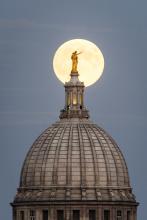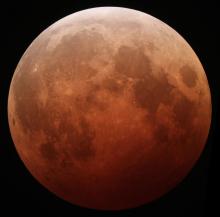Listen to today's episode of StarDate on the web the same day it airs in high-quality streaming audio without any extra ads or announcements. Choose a $8 one-month pass, or listen every day for a year for just $30.
You are here
Moon and Planets
The bright Moon is getting ready to run a gauntlet in the pre-dawn sky – a gauntlet of three planets. The planets align to the left of the Moon at first light tomorrow. The Moon will move past them over the following mornings.
The Moon is in its waning gibbous phase for the next few days. That means that sunlight illuminates more than half of the hemisphere that faces our way, but not the whole hemisphere.
The word “gibbous” comes from a Latin word that means “hump.” It indicates that the Moon looks like it has a hump on its back.
Over the next few days, though, the hump will be getting smaller – where the “waning” part of the title comes in. Tomorrow, the Moon will be about 80 percent full – the Sun will light up 80 percent of the lunar disk. For the following few days, though, that fraction will drop by about 10 percent per day. By Friday, only about 40 percent will be in sunlight. At that point, the Moon will be in its waning crescent phase. The crescent will grow thinner until the Moon disappears in the dawn twilight.
Watch the Moon as it grows thinner over the next few mornings – and passes by a beautiful array of planets. The brightest of the three worlds is Jupiter, the brightest object in the sky at that time other than the Moon. It’s to the left of the Moon tomorrow. Saturn stands close to the left of Jupiter, with orange Mars a good distance to their lower left.
We’ll have more about the Moon and Jupiter tomorrow.





